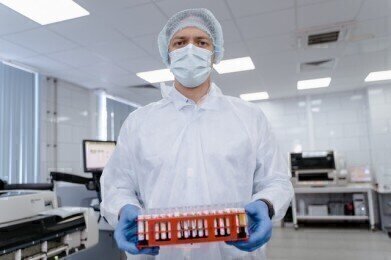News & Views
How Can Sample Processing Be Improved?
Oct 02 2021
To maintain the quality and integrity of biosamples, it’s essential to follow best-practice processing protocols. This improves the quality of biosamples and positions them as valuable diagnostic tools. Ultimately, a high-quality sample gives doctors and lab technicians the best-possible chance at identifying a wide range of diseases, infections and illnesses. With so much at stake, there’s always room for improvement when it comes to biosample processing.
From blood and bronchoalveolar lavage (BAL) to cerebrospinal fluid (CSF) and sputum, read on as we explore some of the ways sample processing can be improved.
-
Preparing the patient
One of the easiest ways to improve the quality of biosamples is to adhere to best-practice patient preparation measures. For example, blood samples should be collected from patients in a basal state. This means the metabolism and body are in resting phase, ideally with no food ingested for at least 12 hours before the sample is collected.
-
Fast and efficient processing
Once collected, taking steps to process the sample in a fast and efficient manner can significantly improve the diagnostic quality of the specimen. The importance of rapid processing is particularly important when collecting cerebrospinal fluid (CSF), which is used to detect a range of conditions in the brain and spinal cord. Bacterium found in CSF samples, including N. meningitidis, H. influenzae and S. pneumoniae, is easily disrupted which means it’s important to process samples in a dedicated facility no more than one hour after collection. If this isn’t possible, solutions like a Trans-Isolate (T-I) medium should be used to preserve the integrity of the specimen until it can be processed and analysed.
-
Choosing the correct specimens
To maximise the diagnostic value of biosamples, it’s important to carefully choose what specimens to collect. This requires in-depth knowledge of the different types of biosamples available and their various uses and applications. For example, urinary pharmacokinetic (PK) samples are a great way to track how a drug is processed by a living organism. When concentrations are low, plasma samples can be a good alternative to blood samples as they offer more detailed information.
-
Investing in high-quality equipment
While state-of-the-art equipment isn’t always necessary, investing in high-quality instruments does help to improve the accuracy and reliability of results. It can also make sample processing faster and more efficient. The Diamond Light Source national synchrotron science facility in the UK boasts some of the most advanced equipment in the country, including next-generation Macromolecular Crystallography (MX) instruments.
While most clinical samples such as blood and surgically excised tissues are discarded as biowaste, when the patient gives consent, they can be transported to biobanks and repurposed for medical research. These types of biosamples underpin medical research carried out at pharmaceutical and biotechnology companies, though unfortunately high-quality specimens can be difficult to secure. Find out more about how Welsh-based company Biosample Hub is advocating for reform in ‘The challenges of biosample access and what needs to change’.
Digital Edition
Lab Asia 31.2 April 2024
April 2024
In This Edition Chromatography Articles - Approaches to troubleshooting an SPE method for the analysis of oligonucleotides (pt i) - High-precision liquid flow processes demand full fluidic c...
View all digital editions
Events
Apr 22 2024 Marrakech, Morroco
Making Pharmaceuticals Exhibition & Conference
Apr 23 2024 Coventry, UK
Apr 23 2024 Kintex, South Korea
Apr 23 2024 Seoul, South Korea
Apr 24 2024 Jakarta, Indonesia




.jpg)













